Crush muscle soreness, increase range of motion and crank up recovery with our breakdown of the best vibrating foam rollers.
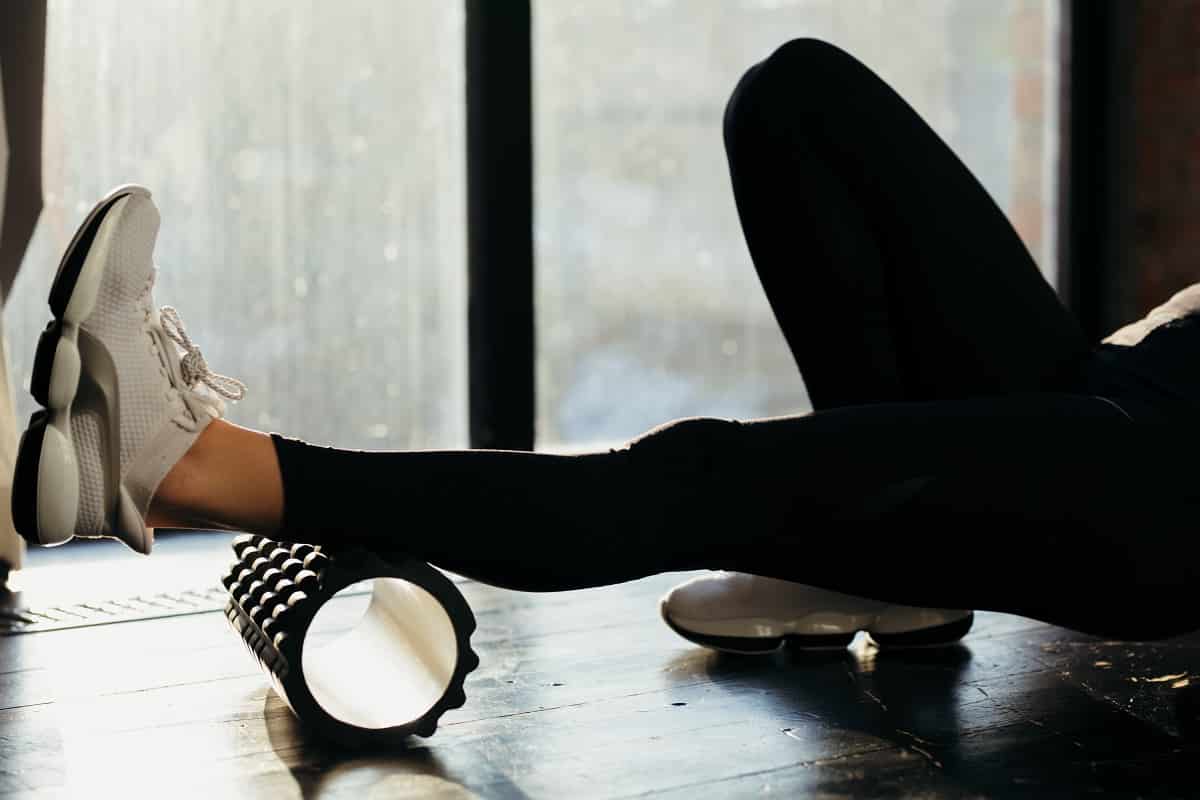
Foam rollers are a killer way to improve mobility and recover from challenging workouts.
While traditional foam rollers and muscle roller sticks do an exceptional job with myofascial release, decreasing soreness, and improving range of motion, vibrating foam rollers take things to the next level.
The benefits of foam rolling have been well documented, but a study with elite athletes found that vibration therapy was a way to reducing delayed onset muscle soreness and improving range of motion.
By combining the benefits of foam rolling with vibration, you get a two-for-one recovery and performance-boosting punch.
Vibrating foam rollers are generally similar, but there are a few different models and types to choose from.
Varying speeds, depth of the knobs and grids, and price are things to consider when choosing the right roller for you.
Read on and get your recovery on with my breakdown of the best vibrating foam rollers.
TriggerPoint GRID Vibe Vibrating Foam Roller
TriggerPoint and their line of foam rollers are one of the original myofascial tools for athletes and gymgoers. Your local gym likely has a range of these brightly colored rollers lining the stretching area.
While the TriggerPoint Grid is the o.g. (and one of the best foam rollers out there), the Grid Vibe takes things to the next level, incorporating a four-speed vibration option. The battery, when fully charged, gives you about two hours of foam rolling joy (or pain, as can sometimes be the case).
The pictured model below is 12-inches long and weighs just 2.5 pounds. Trusted by countless athletes worldwide, TriggerPoint’s GRID Vibe is an excellent addition to your recovery toolkit.
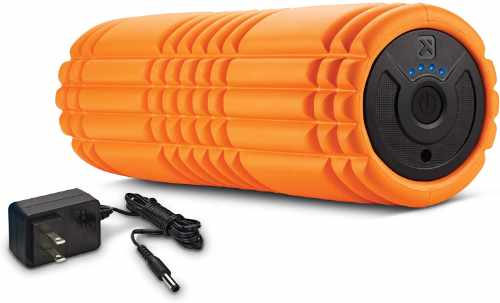
Flyby Vibrating Foam Roller Massager
The first vibrating foam roller I ever tried was this one, the FlyBy Vibrating Foam Roller, on the recommendation of a high-performance athlete I have worked with over the years.
The thing vibrates and vibrates fast—your first time rolling on it will be an experience—up to 3700 vibrations per minute. Four speed settings give you versatility. The battery carries a better charge than the TriggerPoint vibrating roller, with a fully charged battery giving up to four hours of use. (Battery life depends on vibration speed.)
Flyby’s roller is made of a soft and durable EPP foam that doesn’t soak up sweat (one of the key things I look for in gym and recovery gear is how they are going to cope with my overly sweaty skin and soaked shirts).
Light, easy to charge, and with enough speed settings for stubborn knots or a softer massage, the FlyBy Vibrating is an essential tool for better workouts and faster recovery.
(Oh, and it’s also like $10, making it the cheapest on our little list.)
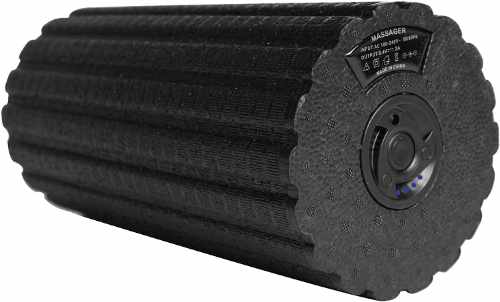
Vulken Vibrating Foam Roller
Want a vibrating roller that is longer? I hear ya.
One of my favorite foam rollers of all time is the Rumble Roller, partly because of the deep knobs but also because of how long it is.
The Vulken Vibrating Foam Roller is longer than traditional rollers (at 17” compared to the “regular” length of 12”) but it isn’t so long that you can’t pack it with you when traveling.
With a peak vibrating speed of 3,800, it will rattle and vibrate your muscles into recovery mode. A rechargeable lithium-ion battery gives you up to four hours of vibrating delight.
The Vulken roller comes with a carrying bag and despite its extra size is very light (just over two pounds).
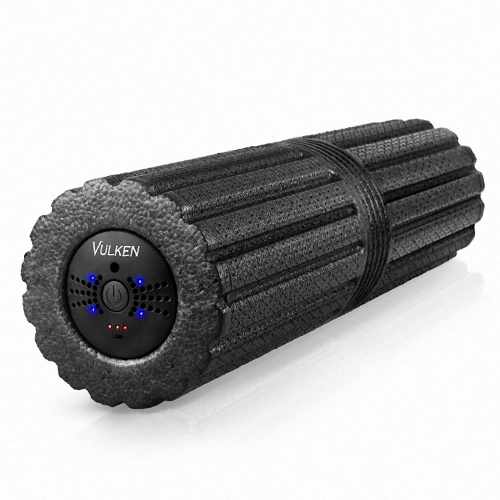
URBNFit 5-Speed Vibrating Foam Roller
Made in the pylon orange that has basically become a staple of foam rollers, the URBFit 5-Speed Vibrating Foam Roller is basically knock-off of the popular TriggerPoint rollers.
Generally, the perk of a good knock-off is a reduced price point, but the URBNFit roller is basically the same price as the TriggerPoint VIBE. So, there’s that.
Key features include up to five speeds (900-3600 vibrations per minute) and a rechargeable battery that is charged through the included micro USB cable.
At its lowest speed setting, the roller can last up to six hours on a full charge, and URBNFit includes a printed and digital guide that walks you through different rolling positions and exercises.
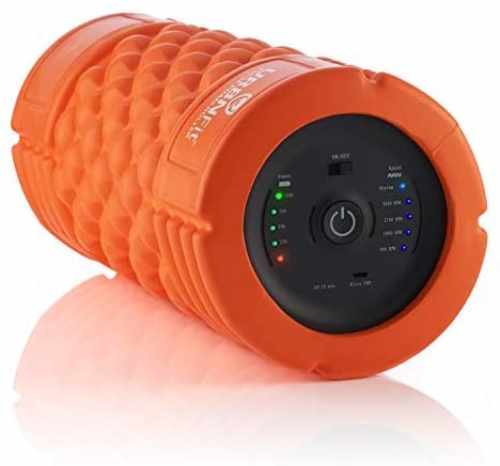
Vibra-Mauler Vibration Foam Roller
Winner of the best name in our collection of vibrating foam rollers has to go to the Vibra-Mauler. Aggressive, bright, and packed with options, it lives up to its name for massage and self-myofascial release.
A digital read-out on the side of the roller gives you speed settings—8 in total, crowning the Vibra-Mauler as the roller with most speed settings. The other side of the roller has a handle making it easy to lug around from your home office to your home gym. (And to your neighborhood gym, too.)
The manufacturer lists 10 hours of use when the roller is fully charged through a USB outlet. At 13-inches it’s a “regular” sized roller, and they back the roller and motor with a 12-month warranty.
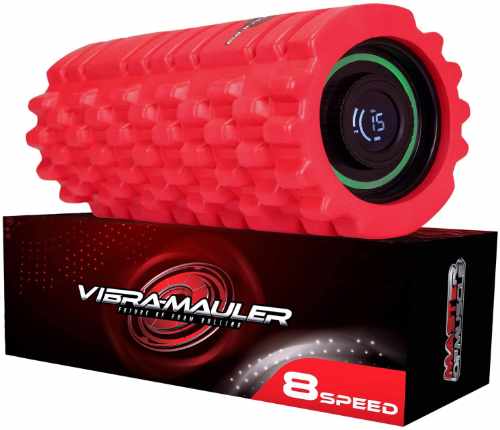
LifePro SURGER Vibrating Foam Roller
No matter what kind of exercise you are doing, the cranked-up motor in the LifePro SURGER Vibrating Roller will increase blood flow, blast away muscle knots, and speed up recovery.
LifePro markets their roller as having the most powerful motor on the market, and it’s hard to disagree the first time you try. On the highest setting, the roller rattles and vibrates hard enough that it looks like it is ready to leave the house and get a job.
With two grid patterns (use the grid for tougher to target muscles and problem areas, the flatter for a more relaxing and soothing massage), four speeds, and a no-questions asked lifetime warranty, LifePro’s SURGER delivers the goods in a compact and powerful roller.
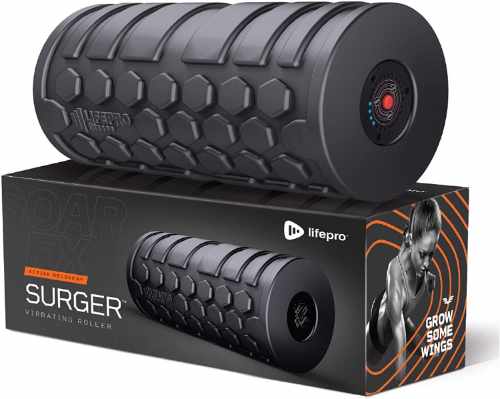
*
How to Choose the Best Vibrating Foam Roller
Vibrating foam rollers tend to fall within the same range when it comes to price. And for the most part, they look similar.
Where they stand apart is in the details—the functions, materials, knob depth, and battery life—of each roller.
Here are the key things to consider.
? Density.
Foam rollers have an exterior shell that is typically made of dense, EVA foam.
This material is great as it’s easy to wipe down (helpful for us sweaty peoples!) and it’s antimicrobial, so it won’t turn into a mosh bit of bacteria over time.
The rigidity of the foam is fairly standard across the crop of the top vibrating foam rollers on the market. It can withstand a lot of weight and won’t rub or chafe the skin.
? Speeds.
Vibrating foam rollers are designed to do just that—vibrate!
Each roller has its own speed settings, ranging from 500 to 4000 vibrations per minute.
The more it vibrates, the more jostling and recovery you can expect to get from it. Choose a vibrating roller that has a range of speeds that line up with your recovery and mobility goals.
For more relaxing rolls, a vibrating roller with a low vibration range of speed is ideal. Athletes, experienced rollers and people with a more muscular, dense build will want a broader range of speeds.
? Grid type.
Vibrating rollers also have a variety of knobs and grid patterns.
TriggerPoint’s grid is basically the standard, giving a couple of variations of depth that allow for both a more relaxing roll and a more targeted approach when you want to really dig at a muscle.
Rollers that have knobs protruding out (similar to the line of Rumble Rollers), like thumbs from the hands of a masseuse, are best suited for people experienced with foam rolling and really want to get after muscle knots.
Muscular users will also want to lean toward a roller that has the protruding knobs to dig past thick muscle tissue and break apart knots and encourage better circulation in target areas.
? Battery life.
All that vibration comes at a cost in terms of electricity. Battery life varies by brand, and how long the battery lasts relies on what speed you use it at.
A vibrating roller that is being used at maximum vibration will drain the battery faster way than if it’s on a slow setting. Seems like an obvious thing to say, but choose a roller that has good battery life.
Most vibrating rollers last in the 4–6-hour range on a full charge and are being used at their most power-saving speed.
Are vibrating foam rollers more effective than regular foam rollers?
Vibrating foam rollers are pricier than their non-vibrating brothers from another mother. Which can make it difficult to justify the investment.
But there is some research that outlines how a vibrating roller can be more effective at reducing perceived pain and increasing range of motion compared to a regular foam roller.
In a study of around 40 healthy adults, either a foam roller or vibrating roller were used for recovery purposes 48-hours after a rigorous workout of 10×10 eccentric squats.
The vibrating roller group stood out in reduced pain perception (i.e. they felt less sore) and increased range of motion in the hip joint compared to using a regular roller.
How does a vibrating foam roller work?
A vibrating foam roller combines two proven recovery modalities—self-myofascial release and vibration therapy—to give a one-two punch for faster recovery, reduced muscle soreness, and less tightness in ligaments and muscle tissue.
It’s used in the same way as a traditional foam roller. Roll out the target area, moving your body across the dense foam, working out soreness and tightness.
The vibration jostles muscle tissue and encourages even more blood circulation, speeding up recovery and loosening up tight muscles.
Vibration has repeatedly been shown to be an effective means of reducing muscle soreness and increasing range of motion after strenuous exercise1.
With both athletes and non-athletes vibration therapy can also:
- Increasing neuromuscular performance in athletes
- More explosive performance
- Increased blood flow under the skin
- Better kinesthetic awareness
- Muscular strength and power development
When is the best time to use a vibrating foam roller?
There is a lot of research on the benefits of foam rollers.
Used after a big workout, and in the days that follow, are when it’s most effective at reducing muscle soreness and improving athletic performance2.
For general range of motion, just twenty minutes of foam rolling can significantly increase mobility and muscle activation3.
Combined with static stretching, foam rolling is also a proven way to increase flexibility (faster than static stretching alone)4.
There is not really a wrong time to use your roller.
I often do a quick roll targeting my upper back when sitting for extended periods of time. Or use it as part of my warm-up. Or even when watching TV at night with my wife when I need to relax after a stressful day.
The Bottom Line
Ultimately, the vibrating roller you choose should match up with your goals in the gym and with your body.
For most users, the TriggerPoint VIBE Vibrating Foam Roller is an excellent all-purpose roller that has a ton of speed choices and the backing of an industry-leader in building foam rollers.
More experienced users will love the Vibra-Mauler Vibrating Foam Roller for its deep knobs for tackling hard-to-reach areas and knot-busting design.
Pick the right vibrating roller for you. Use it before and after your workouts. And reap the benefits of more explosiveness, better range of motion, and less muscle soreness.

